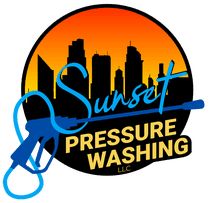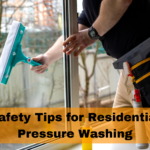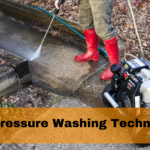
Commercial Pressure Washing Safety Protocols
In the realm of commercial maintenance, pressure washing stands out as a powerhouse technique, capable of rejuvenating buildings, sidewalks, and public spaces, thus restoring their appeal and extending their lifespan. However, the very power that makes pressure washing so effective also introduces significant safety risks if not managed with care. Understanding and implementing safety protocols is not just a recommendation; it’s a necessity to protect operators, bystanders, and property from the potential hazards associated with high-pressure water streams and the chemicals often used in the cleaning process.
We aim to shed light on the critical safety protocols that must be adhered to in commercial pressure washing operations. Whether you’re a novice entering the field or a seasoned professional looking to refresh your knowledge, the forthcoming sections will provide valuable insights into the safe and effective use of pressure washing equipment. From the selection of appropriate machinery and personal protective gear to the correct handling of chemicals and the nuances of operating techniques, we’ll cover the essential aspects that ensure safety is at the forefront of your commercial pressure washing tasks.
By emphasizing these safety protocols, our goal is to equip you with the knowledge to conduct your pressure washing activities not only effectively but with the utmost regard for safety. Let’s dive into the world of commercial pressure washing, where power meets precision, guided by the paramount principle of safety first.
Understanding Commercial Pressure Washing Equipment
Commercial pressure washing is a critical maintenance task for businesses, contributing significantly to preserving the aesthetic appeal and longevity of their premises. However, the effectiveness and safety of pressure washing operations hinge on a deep understanding of the equipment involved. This section delves into the types of pressure washers used in commercial settings, the importance of selecting the right equipment for specific tasks, and the personal protective equipment (PPE) required for safely operating these powerful machines.
Types of Pressure Washers
Commercial pressure washers come in various forms, each designed to cater to different cleaning needs. The two primary categories are electric and gas-powered pressure washers. Electric models are quieter and emit no exhaust, making them ideal for indoor use or in environments where noise and air pollution are concerns. Gas-powered models, on the other hand, offer more power and mobility since they’re not tethered by a power cord, making them suitable for extensive outdoor cleaning tasks.
Beyond the power source, pressure washers also vary in pressure output, measured in pounds per square inch (PSI), and water flow, measured in gallons per minute (GPM). High PSI units are effective at removing stubborn stains and grime, while high GPM units rinse surfaces more quickly. Selecting the right combination of PSI and GPM is crucial for efficient cleaning without damaging the surface being cleaned.
Choosing the Right Equipment
Selecting the appropriate pressure washer for a task requires understanding the surface material and the type of dirt or grime being removed. Using a pressure washer with too much power on delicate surfaces can cause damage, while a unit with insufficient power may not effectively clean the targeted area. Professionals must assess the job at hand and choose equipment that balances power with precision.
Personal Protective Equipment (PPE)
Safety is paramount in commercial pressure washing. Operators must wear appropriate PPE to protect against high-pressure water jets, flying debris, chemicals, and noise. Essential PPE includes:
- Safety Goggles or Glasses: To protect eyes from flying debris and chemical splashes.
- Waterproof Gloves: To maintain grip and protect hands from chemicals and high-pressure water.
- Ear Protection: To safeguard hearing against the noise of gas-powered models.
- Steel-Toe Boots: To protect feet from heavy equipment and falling objects.
- Waterproof Clothing: To stay dry and protect the skin from harsh cleaning chemicals.
Understanding and utilizing the right commercial pressure washing equipment is not just about achieving cleanliness; it’s also about ensuring the safety of operators and the public, as well as preventing damage to property. With a comprehensive grasp of the types of pressure washers available, how to select the right one for a specific job, and the necessary PPE, businesses can maintain their premises effectively and safely.
Pre-Operation Safety Checks
Before commencing any commercial pressure washing activity, conducting thorough pre-operation safety checks is crucial. These checks are designed to ensure that the equipment is in optimal condition, thereby minimizing the risk of accidents and enhancing operational efficiency. Here’s a detailed look at the necessary steps:
Equipment Inspection
- Check the Pressure Washer: Begin with a visual inspection of the pressure washer. Look for any signs of wear, tear, or damage on the machine, paying close attention to the hoses, nozzles, and gun. Any damaged components should be replaced immediately to prevent accidents.
- Inspect Hoses and Connections: Ensure that all hoses are securely connected and free of kinks or leaks. High-pressure hoses are particularly prone to wear and damage, which can result in dangerous failures under pressure.
- Nozzle and Filter Check: Clean and inspect the nozzles and filters. Blocked or damaged nozzles can alter the pressure and spray pattern, potentially causing unexpected injuries or damage to surfaces.
- Fuel and Oil Levels: For gas-powered pressure washers, check the engine oil and fuel levels. Running a washer with low oil can cause engine damage, while incorrect fuel levels can lead to operational interruptions.
Review Operational Manual and Safety Guidelines
Familiarize yourself with the manufacturer’s manual. It contains specific instructions and safety warnings relevant to the model you’re using. Ensure all operators have read and understood these guidelines before use.
Secure Working Area
- Establish a Safety Perimeter: Set up barriers or safety signs to keep unauthorized personnel and bystanders at a safe distance from the operation area. This is especially important in commercial settings where the public might inadvertently enter the workspace.
- Remove Hazards: Clear the area of any potential tripping hazards or objects that might obstruct the operation. This includes securing loose wires or cables and ensuring the surface is stable and slip-resistant.
- Plan Your Workflow: Identify the best starting point and progression for the job to avoid working in previously cleaned areas, which might be slippery. Plan your exit strategy for emergency shutdowns or quick breaks.
- Weather and Environmental Conditions: Consider the weather and environmental conditions. Operations should not be conducted during adverse weather conditions such as heavy rain, winds, or lightning due to increased risks.
- Personal Protective Equipment (PPE): Ensure all operators are equipped with the appropriate PPE. This includes safety goggles or face shields, waterproof gloves, ear protection, and non-slip boots. Depending on the chemicals used, additional protective clothing may be necessary.
By adhering to these pre-operation safety checks, commercial pressure washing can be conducted safely and effectively, protecting both operators and the public from potential hazards. Remember, safety is not just a protocol but a practice that ensures the well-being of everyone involved in and around the pressure washing activity.
The Correct Use of Chemicals and Cleaning Agents
In the realm of Sunset Pressure Washing, the use of chemicals and cleaning agents is often necessary to tackle tough grime, oil stains, and various types of build-up that water alone can’t handle. However, these powerful substances come with their own set of risks and responsibilities. Understanding how to use these chemicals safely and effectively is paramount to protect both the operator and the environment.
Choosing the Right Chemicals
The first step in safe chemical use is selecting the appropriate cleaning agents for the job. Not all surfaces are created equal, and using the wrong chemical can cause damage to the surface being cleaned, harm the operator, or negatively impact the environment. It’s essential to:
- Read labels carefully: Look for information on recommended uses and any surfaces or materials that should be avoided.
- Understand chemical concentrations: Some chemicals need to be diluted before use, while others are ready-to-use (RTU). Following the manufacturer’s instructions is crucial to ensure effectiveness and safety.
- Consider biodegradable options: Whenever possible, choose environmentally friendly chemicals that break down into non-harmful substances after use. This choice is especially important when washing surfaces that may drain into sensitive areas, like waterways.
Safe Handling and Storage
Proper handling and storage of chemicals are key to preventing accidents and ensuring that the chemicals maintain their efficacy. This includes:
- Wearing appropriate personal protective equipment (PPE): Depending on the chemicals used, PPE can include gloves, goggles, respirators, and protective clothing.
- Storing chemicals properly: Keep chemicals in their original containers with labels intact, and store them in a cool, dry place away from direct sunlight and extreme temperatures. Ensure that storage areas are locked or otherwise secured to prevent unauthorized access.
- Preventing cross-contamination: Use separate measuring devices for different chemicals and never mix chemicals unless explicitly directed by the product guidelines.
Application and Disposal
When applying chemicals, following the product’s instructions is vital for both safety and effectiveness. Techniques for safe application include:
- Applying chemicals in well-ventilated areas: This minimizes the inhalation of fumes, which can be harmful.
- Avoiding overspray: Use chemicals sparingly to prevent unnecessary runoff, which can harm surrounding vegetation and wildlife.
- Monitoring weather conditions: Avoid applying chemicals during windy conditions or when rain is expected shortly after treatment, as this can lead to chemical drift or runoff.
Proper disposal of chemicals and their containers is just as important as safe handling. Never pour unused chemicals down the drain, on the ground, or into waterways. Instead:
- Follow the label instructions for disposal: Many chemicals have specific disposal instructions that must be followed to comply with local regulations.
- Use designated disposal facilities: Hazardous waste should be taken to a facility equipped to handle such materials. Contact local waste management authorities for guidance on disposing of chemicals properly.
The effective and responsible use of chemicals and cleaning agents in commercial pressure washing is non-negotiable for safety and environmental protection. By choosing the right chemicals, handling them safely, and adhering to proper application and disposal methods, operators can ensure that their cleaning tasks are completed efficiently without compromising on safety. Continuous education on chemical safety and staying informed about the latest regulations and best practices are essential steps in maintaining a safe working environment for all involved.
Operating Techniques for Injury Prevention
Operating commercial pressure washers requires skill, awareness, and adherence to safety protocols to prevent injuries. High-pressure water streams can cause severe injuries and damage to property if not handled correctly. Here are essential operating techniques aimed at injury prevention:
Proper Handling and Stance
- Maintain Balance: Always stand with your feet shoulder-width apart to maintain balance when using a pressure washer. The force of the water can be strong enough to cause imbalance, leading to falls and slips.
- Two-Handed Operation: Use both hands to hold the pressure washing gun. This provides better control over the direction and strength of the water stream, reducing the risk of accidental spraying.
- Avoid Locking Arms: Keep your elbows slightly bent to absorb the recoil of the pressure washer gun. Locking your arms can lead to muscle strain and loss of control.
Managing Recoil and Pressure
- Gradual Trigger Engagement: Slowly squeeze the trigger to start the water flow, allowing you to adjust to the recoil before the pressure reaches its full strength.
- Pressure Adjustment: Before beginning, adjust the pressure settings according to the task at hand. Using excessively high pressure not only risks injury but can also damage the surface being cleaned.
Preventing Slips, Trips, and Falls
- Clear Work Area: Before starting, remove potential trip hazards from the work area. This includes tools, hoses, debris, and any slippery substances.
- Use Signage: In commercial settings, use signs or barriers to warn others of the wet and potentially slippery areas.
- Appropriate Footwear: Wear non-slip, sturdy shoes that provide grip and protect your feet from accidental sprays and falling objects.
Safe Distance and Direction
- Maintain Safe Distance: Keep a safe distance from the surface you are cleaning. Too close, and you risk ricochets and water splash-back; too far, and you might not clean effectively.
- Direct Spray Away from People: Never point the pressure washer at people, animals, or delicate objects. The force of the water can cause injury or damage.
- Be Aware of Surroundings: Always be aware of your surroundings, particularly when working in areas with pedestrian traffic, to avoid accidental spraying of bystanders.
Emergency Response and First Aid
In the realm of commercial pressure washing, the intensity and nature of the work can sometimes lead to unforeseen accidents or emergencies. Being prepared with a solid emergency response plan and basic first aid knowledge is not just a recommendation—it’s an imperative part of maintaining a safe working environment. This section will cover basic first aid measures for common injuries, emergency shutdown procedures for pressure washing equipment, and essential practices for responding to accidents.
Basic First Aid Measures
- Chemical Exposure: If chemicals used in the washing process come into contact with skin or eyes, immediate flushing with clean, cool water is crucial. For skin exposure, rinse the area for at least 15 minutes and remove any contaminated clothing. In the case of eye exposure, flush the eye with water for at least 15-20 minutes and seek medical attention immediately.
- Cuts and Abrasions: Minor cuts and abrasions can occur from handling equipment or accidental contact with sharp objects. Clean the wound thoroughly with water and mild soap, apply an antibiotic ointment, and cover with a sterile bandage. For deeper cuts, apply pressure to stop the bleeding and seek professional medical assistance.
- Pressure-Related Injuries: The high-pressure stream from a washer can cause serious injuries, including lacerations or even injection injuries that force water or chemicals under the skin. Such injuries require immediate medical attention, regardless of how minor they might seem.
Equipment Shutdown and Emergency Procedures
In an emergency, knowing how to quickly and safely shut down your pressure washing equipment is vital to prevent further harm. Ensure that all operators are familiar with the shutdown procedures:
- Immediate Shutdown: Every pressure washer has an off switch or button that should be clearly marked and accessible. Operators should be trained to reach it quickly and shut down the machine without hesitation in case of an emergency.
- Pressure Release: After shutdown, release any built-up pressure in the system according to the manufacturer’s instructions to avoid accidental discharges.
Responding to Accidents
Even with the best precautions, accidents can happen. Having a plan in place ensures that everyone knows how to respond effectively:
- Stay Calm and Assess the Situation: Quickly assess the situation to understand the extent of injuries or damage. Keeping calm helps in making rational decisions.
- Call for Help: If the situation warrants, do not hesitate to call emergency services immediately. Provide them with clear information about the location and nature of the emergency.
- Provide First Aid: Administer first aid within the scope of your knowledge and training while waiting for professional medical help to arrive.
- Document the Incident: Once the situation is under control, document the incident in detail for future reference and to improve safety measures.
Emergency preparedness and the ability to provide first aid are critical components of commercial pressure washing operations. By equipping your team with the knowledge and tools they need to respond to accidents, you’re not just complying with safety regulations—you’re actively protecting the well-being of your employees and clients. Remember, the goal is not just to react to emergencies, but to create an environment where accidents are less likely to occur through education, training, and adherence to safety protocols.
Maintenance and Post-Operation Procedures
Ensuring the longevity and safety of commercial pressure washing equipment is not just about how you use it; it’s also about how you care for it after the job is done. Proper maintenance and postoperative procedures are essential to keep your equipment in top condition and ready for the next job. Here’s a detailed guide on maintaining your commercial pressure washing gear and the steps to follow after each use.
Routine Maintenance Checks
After every use, it’s crucial to perform routine maintenance checks. This involves inspecting the hoses for any signs of wear or damage, such as cuts, leaks, or bulges, which could lead to failures under high pressure. Nozzles and spray guns should be checked for clogs or damage that could affect their performance or create safety hazards. The engine and pump system also require a check-up; look for any leaks, unusual noises, or signs of wear that might need professional attention.
Regularly changing the oil in your pressure washer’s engine and pump according to the manufacturer’s recommendations helps ensure the longevity and reliability of your equipment. Additionally, filters should be cleaned or replaced regularly to prevent clogs and maintain optimal performance.
Cleaning and Storing Equipment Properly
After ensuring that all parts are in good working order, thoroughly clean your pressure washer. Remove any debris or chemicals from the machine, paying special attention to the nozzles and hoses, as leftover chemicals can degrade the materials over time. Allow all parts to dry completely before storage to prevent rust and corrosion.
When storing your pressure washer, choose a clean, dry place away from direct sunlight and extreme temperatures to avoid damage to the hoses and seals. If possible, store the machine and its accessories off the ground to protect them from moisture and pests.
Reviewing the Work Area
Once the equipment is taken care of, turn your attention back to the work area. Ensure that all cleaning agents and water have been properly disposed of, following local regulations, especially if you’ve used chemicals that could harm the environment. Check the area for any damage that may have occurred during the cleaning process and take steps to address it immediately to maintain a good relationship with clients and uphold professional standards.
Additionally, it’s essential to ensure that the area is safe for public access. Remove any warning signs or barriers you’ve placed around the work area, and inspect the surface for slip hazards that could pose risks to people.
The Importance of Proper Maintenance and Care
Regular maintenance and proper post-operation procedures extend the life of your pressure washing equipment, reduce the likelihood of breakdowns, and ensure that you’re always ready for the next job. It also plays a crucial role in safety, helping to prevent accidents and injuries caused by faulty equipment. Taking the time to care for your gear after each use is an investment in your business’s efficiency, safety, and professionalism.
By following these maintenance and post-operation procedures, you not only protect your investment in commercial pressure washing equipment but also contribute to a safer working environment for yourself, your employees, and the public. Remember, well-maintained equipment is the foundation of a successful and reputable commercial pressure washing business.
Training and Certification
Importance of Formal Training Programs for Operators
Safety and efficiency in commercial pressure washing hinge not just on the quality of the equipment used but significantly on the skill and knowledge of the operators. Formal training programs play a pivotal role in preparing operators for the myriad challenges they may face on the job. These programs cover a broad spectrum of necessary knowledge, including the operation of various pressure washers, understanding of different surface types, chemical use, and safety protocols. Through structured training, operators gain a comprehensive insight into best practices in pressure washing, ensuring they can perform their duties not just effectively but safely.
Overview of Certifications Available for Commercial Pressure Washing Professionals
Certification serves as a testament to an operator’s proficiency and commitment to excellence in the field of commercial pressure washing. Numerous organizations offer certifications that validate an individual’s skills, knowledge, and adherence to industry standards. For example, the Pressure Washing Institute and similar bodies provide certifications that are recognized across the industry. These certifications often require the completion of coursework, passing an examination, and sometimes, accruing a certain number of hours of practical experience. Obtaining a certification not only boosts an operator’s credentials but also instills confidence in clients about the quality and safety of the work being performed.
Continuous Education on Safety Standards and New Equipment
The realm of commercial pressure washing is ever-evolving, with advancements in technology, equipment, and safety standards. Continuous education is crucial for operators to stay abreast of these changes and incorporate them into their practices. This could mean learning about new types of pressure washers that are more efficient and safer to use, or updated safety regulations that affect how pressure washing is performed commercially. Additionally, ongoing education can involve training on the latest environmentally friendly cleaning solutions and methods that reduce the ecological impact of pressure washing activities.
Operators should view training and certification not as a one-time requirement but as an ongoing commitment to professionalism and safety. This commitment not only enhances their capability and service quality but also contributes to the overall reputation and trustworthiness of the commercial pressure washing industry. Encouraging a culture of continuous learning and adherence to best practices ensures that the industry evolves in a direction that prioritizes both efficiency and safety.
Training and Certification
In the realm of commercial pressure washing, the line between efficient cleaning and hazardous mishaps is defined by the adherence to stringent safety protocols.Understanding and implementing these safety measures is not just a regulatory requirement but a cornerstone of professional practice that safeguards operators, bystanders, and property.
The significance of familiarizing oneself with the equipment, conducting pre-operation safety checks, and employing the correct operating techniques cannot be overstated. It ensures that each task is performed efficiently, without compromising on safety. Moreover, the responsible handling and disposal of chemicals protect both the environment and the health of those involved.
Emergency preparedness, through both rapid response and preventive maintenance, further underlines the importance of safety in preventing accidents and ensuring a quick resolution should they occur. And, as the industry evolves, continuous training and certification ensure that operators remain at the forefront of best practices and technological advancements.
Safety in commercial pressure washing is not just a series of actions but a culture that needs to be cultivated and maintained. It is the responsibility of every individual involved to prioritize safety above all else, ensuring not just the longevity and cleanliness of the properties we service but the well-being of our communities.
Let us move forward with a commitment to safety, excellence, and continuous improvement in our commercial pressure washing endeavors. By doing so, Sunset Pressure Wash not only elevate our professional standards but also contribute to a safer, cleaner, and more sustainable world.






